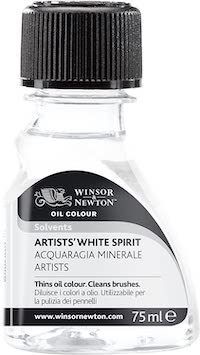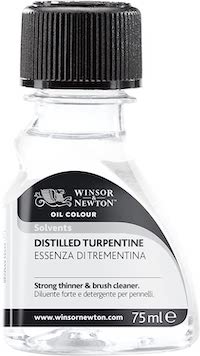If you use oil paints, then you will certainly have to use solvents to thin paints as well as mediums. You will also have to use solvents for cleaning brushes and palettes.
Both white spirit and turpentine are used as these solvents. However, there is a massive difference between these two.
What’s the difference between white spirit and turpentine? Turpentine is made from natural resin that is extracted from trees whereas white spirit is formulated from petroleum distillates. Turpentine is less toxic, but white spirit is less flammable.
In order to understand the difference between the two, a better understanding is needed about their properties and applications.

White Spirit
White spirit is known by numerous names. It is popular as ‘mineral spirit‘ in Canada and the U.S. In New Zealand and Australia, it is referred to as ‘mineral turpentine.’ It is also referred to as paint thinner, petroleum spirit, and as a turpentine substitute.
In fact, if you come across any paint solvent that has the word mineral written over it, then it is most likely just white spirit called by another name!
Winsor & Newton offers an artist-specific white spirit that works well.
Whatever you call it, white spirit is a solvent that is generally used for cleaning tools and machinery. It is also used for thinning paints and varnishes and even cleaning off old or improperly applied varnishes.
Benefits of Using White Spirit
There are many reasons to use white spirit – and not just because it works well to thin paints and varnishes and to clean those hard-to-clean tools and machinery.
Some of the biggest benefits of using white spirit are:
1. White spirit is less toxic than regular paint thinner.
Paint thinners are usually toxic and can result in terrible side effects. However, white spirit has a lower toxicity and less odor, which makes it both safer and easier for people to use.
2. White spirit is more effective than paint thinner.
White spirit is a refined form of paint thinner. It is more effective in terms of solvent properties and cleaning capabilities. This is because it is a more purified form of thinner.
This purity – and its effectiveness – are why painters prefer using white spirit. However, it is also double the cost of paint thinner as it undergoes refinement process, so this may not be every beginner or amateur’s first choice, no matter its high performance.
Downsides of Using White Spirit
No material is perfect, and white spirit is no exception. Here are a few downsides to using the thinning solvent:
1. The fumes are potent.
White spirit has a strong smell and can result in dizziness. Hence, it must always be used in a well-ventilated room or even outside if you can. You can have contact dermatitis if used for a long time. Using nitrile gloves can prevent skin irritation.
2. You probably can’t use it on your oil paintings.
You should never use household white spirit on oil paintings. This is because it consists of more impurities in comparison to residual sulfur. However, you can go for a specialized artist’s white spirit that is free from residual sulfur and which will not deteriorate your work.
Tips For Using White Spirit
When using white spirit, you want to be careful. It may be less toxic than other paint thinners, but that doesn’t mean it’s as safe as water.
When you use white spirit, consider these tips:
- Avoid using it in your indoor painting studio
- Opt for refined white spirit, or the one with the lowest odor
- Consider it for cleaning brushes after an oil painting session, and even your palette after a painting is finished
Turpentine
Turpentine is also referred to as oil of turpentine or spirit of turpentine. It is slightly more viscous in comparison to the white spirit.
Good quality turpentine (like this one) will have the smell of pine trees that have been used to make it. For making turpentine, oleoresin secreted from the bark of the tree is collected. It is then purified using a distillation process.
Turpentine accelerates the drying time in comparison to mineral spirits or paint thinners. It also accelerates the polymerization of the oil film. It incorporates oxygen into the mix thereby oxidizing the paint layer from inside out. Turpentine can result in the softening of the previous paint layers as it is quite a powerful solvent.
Oil paints became insoluble to most solvents after exposure to atmospheric oxygen by six months. Petroleum-based solvents do not have any impact on the layer while glazing. Turpentine is stronger and evaporates faster.
However, turpentine is flammable. It also emits vapors that can irritate eyes and lungs. Long term exposure to turpentine vapors in a poorly ventilated room can result in damage to the lungs.
Never use household turpentine on your artwork. It can leave a gum residue on your painting and may turn it yellow over time. You need to use artist’s turpentine. It has fewer impurities and will perform better. It will dry quickly and will not result in the yellowing of your precious artwork.
Benefits of using Turpentine for your paint project
1. Turpentine increases the efficacy of varnishes and paints.
Turpentine is an extremely useful solvent for oil paints. Generally, oil paints have a thicker consistency and in order to make them thin before application, a solvent needs to be used.
It is one of the most effective solvents owing to its high evaporation rate. It also facilitates quicker drying of the paint. This makes it easier to apply paint and enables effective application.
2. It’s an effective cleaning agent.
Turpentine is an effective cleaning agent for paintbrushes. If you have been having a hard time cleaning your brushes, then this oil-based solvent will prove to be effective.
Turpentine can remove hard to clean paint from hardened paintbrushes. Simply dip such paintbrushes in turpentine and swirl them a few times to clean them thoroughly.
3. It’s a healthier, non-toxic choice of solvent.
Turpentine is not toxic like the petroleum-based solvent white spirit. This makes it comfortable to use the solvent if you suffer from allergic reactions. This solvent offers a safer work environment.
4. Turpentine is more eco-friendly.
Numerous solvents are available in the market for use in painting purposes. However, petroleum distillates are part of various paint solvents. Such compounds contribute to environmental pollution.
Turpentine is made from pine bark extracts. Hence, it is free from such ingredients that are harmful to the environment and is absolutely safe to use. As long as it is harvested sustainably, it can be a very eco-friendly choice.
What to Use: Rectified Spirit of Turpentine
The highest quality turpentine is rectified spirit. It is made purely from the resin obtained from the pine trees. It has a clean and pleasant scent.
Turpentine made from forest waste is of low grade and has a bad odor. Although it is possible to purify turpentine of low grade, it will always carry an unpleasant smell.
Larch Venice Turpentine is a professional-grade painting medium. It is not suitable for cleaning brushes and thinning paints. This turpentine is collected from the larch tree and is highly viscous. It is also free from abietic acid crystals that result in discoloration.
Larch Venice turpentine will not result in the yellowing of the painting medium. It dries and leaves enamel-like gloss. It is thixotropic and is slow drying. Larch Venice is an amazing ingredient for use in varnishes and glaze mediums.
There are numerous citrus-scented turpentine available in the market. These are non-flammable and closer to turpentine than distillates obtained from petroleum. These will not leave any residue. These make great solvent for thinning mediums and oil paints. These are also great in cleaning up.
More to Know About Turpentine
Here are a few more facts summarizing turpentine and its benefits:
- Turpentine is flammable and stronger than most of the petroleum distillate solvents. Citrus based solvents are non-flammable, however, and barely emit fumes.
- Don’t use household turpentine in the art studio as it can leave a residue in the painting medium. Pure turpentine is ideal for cleaning palettes and brushes. Use turpentine for thinning alkyd paints.
- Triple distilled turpentine dries evenly and more quickly. The highest grade turpentine has a pleasant fragrance of pine trees.
- Turpentine thickens when exposed to air.
White Sprit Vs Turpentine
Turpentine and White Spirit can be used for both cleaning brushes and for diluting color. However, there are distinct differences between these two solvents.
1. Handling Properties
Distilled turpentine is more viscous in comparison to artist’s white spirit. White spirit tends to result in more watery mixes. If you are skilled and want a thinner consistency, handling may be less of an issue, however.
2. Stability
A residue of gum in distilled turpentine will prevent oil from drying. This gum can also contribute to yellowing. Hence, it is quite essential to make use of the artist’s turpentine instead of pure turpentine that is used in home decorations.
The artist’s version has gum removed from it by the process of distillation. Moreover, turpentine will oxidize if left exposed to air or daylight. This can result in yellowing and tackiness in the painting. Distilled turpentine must also be stored in a sealed, well-fitted bottle. It should be placed away from daylight.
White spirit does not have any gum residue. Hence, it will not deteriorate under any storage conditions. It is the more stable option.
3. Toxicity
Turpentine is non-toxic and a safer choice than white spirit. White spirit is less toxic than other thinners and solvents, but can still be dangerous if used often and improperly in poorly-ventilated spaces.
Although turpentine is less toxic in comparison to white spirit, it can result in allergic reactions.
Whenever using any solvent for painting purposes, it is best to paint in a room that is well-ventilated. You will find the fumes from solvent suffocating. Consider all the options available in the market and choose solvents that are safe for you. Read the manufacturer’s label carefully for usage instructions.
Conclusion
If you are really concerned about the way your painting looks, it is crucial to choose a medium carefully. Turpentine is often considered a superior cleaning spirit and thinner used by artists working with oil paints. Mineral spirits or white spirits are a derivative of petroleum and will thin paints, but are fairly toxic.
One should not thin oil paints more than it is necessary. This may otherwise result in the weakening of the paint film. Do not use white spirt for thinning oil colors. Always use paint thinners in well-ventilated spaces.
Up Next: The 5 Best Paint Brushes For Oil-Based Paint

